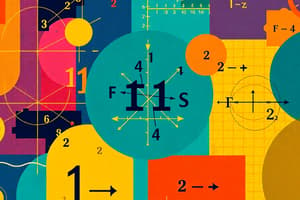Podcast
Questions and Answers
What are the characteristics of mathematical language?
What are the characteristics of mathematical language?
- Precise
- Concise
- Powerful
- All of the above (correct)
What is mathematical language?
What is mathematical language?
A system of communication about objects like numbers, variables, sets, operations, functions and equations.
The set of natural numbers is represented by the symbol ______.
The set of natural numbers is represented by the symbol ______.
N
The set of rational numbers is represented by the symbol ______.
The set of rational numbers is represented by the symbol ______.
Which of the following symbols represents an element?
Which of the following symbols represents an element?
Mathematical language is difficult to understand because the ideas are complex.
Mathematical language is difficult to understand because the ideas are complex.
What does the symbol 'R' represent in mathematical language?
What does the symbol 'R' represent in mathematical language?
Study Notes
Mathematical Language
- Understanding mathematical language is essential for grasping mathematical ideas, as the concepts can often seem foreign without proper terminology.
- It is a system of communication that deals with objects like numbers, variables, sets, operations, functions, and equations.
- Mathematics has its own specialized vocabulary, grammar, and syntax.
Characteristics of Mathematical Language
- Precision: Enables the articulation of very fine distinctions in thought.
- Conciseness: Allows for expressions to be made brief and to the point.
- Powerfulness: Capable of articulating complex ideas with relative ease.
Mathematical Symbols and Notations
- Common operational symbols include:
- Addition: +
- Subtraction: −
- Multiplication: ×
- Division: ÷
- Symbols representing values typically include letters such as:
- a, b, c, x, y, z, etc.
Number Sets and Their Symbols
- N: Set of natural numbers {1, 2, 3, 4,...}
- W: Set of whole numbers {0, 1, 2, 3, 4,...}
- Z: Set of integers {..., −2, −1, 0, 1, 2,...}
- R: Set of real numbers (−∞, ∞)
- Q: Set of rational numbers {ab : a, b ∈ Z ∧ b ≠ 0}
- QC: Set of irrational numbers {x | x is a nonrepeating and nonterminating decimal}
- C: Set of complex numbers {x + iy : x, y ∈ R, i² = −1}
Logical Symbols
- ∧: Represents logical "and"
- ∨: Represents logical "or"
- ∈: Indicates an element of a set
- /∈: Indicates not an element of a set
- →: Symbolizes "if - then"
- ↔: Represents "if and only if"
- ∀: Means "for any" or "for all"
- ∃: Signifies "there exists" or "there is"
- ∴: Symbolizes "therefore"
- ∩: Represents intersection
- ∪: Represents union
Studying That Suits You
Use AI to generate personalized quizzes and flashcards to suit your learning preferences.
Description
Explore the fundamental aspects of mathematical language and symbols in this module for GE 112: Mathematics in the Modern World. Topics covered include elementary logic, sets, and the foundations of mathematical expression. Enhance your understanding and application of mathematical terminology.




